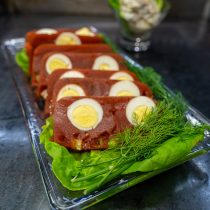Magazine

Food at U-M: Then and Now
When the renovated Michigan Union opened in January 2020, it boasted new restaurants such as Taco Bell and Panera, as well as returning eateries such as Wendy’s and Subway.
Grabbing a quick bite to eat is certainly par for the course for students today, but 100 years ago, students’ meals were different.
Although U-M didn’t keep official food or dining records a century ago, Lisa Young, a Department of Anthropology faculty member, has used Bentley archival materials to determine what students were eating, and why.
First-year students in Young’s course Food at U-M: Then and Now studied Bentley scrapbooks from 1910–1920, using food as a lens to understand U-M history. Sorority, fraternity, and church banquets often had programs with menus, and students frequently saved them in their scrapbooks.
Many banquet menus featured dishes unfamiliar to current students: chicken timbales, tomato aspic, Waldorf Salad, and mulligatawny soup (see sidebar). To track down how the dishes were made, the class used the Jan Bluestein Longone Culinary Archive at U-M’s Special Collections Research Center to find recipes.
Young and her students also studied accounting books from local farms, including the Bentley’s records from Allen Farm. Seeing what the farm was selling gave them a sense of how small local farms could have provided much of the banquet food.
Because World War I food conservation efforts likely affected some of the banquets, Young’s students paid particular attention to cookbooks in the Longone collection including Conservation Recipes and War-Time Cook and Health Book. These cookbooks explained how to make dishes like the chicken timbales without ingredients such as eggs and butter.
The banquets were special occasions and often included multiple desserts, which would have been a rare treat for students. The most common desserts were ice cream and cake, both of which were labor intensive to make in kitchens without electricity and freezers. For example, making a cake required sifting flour five times, and without electric mixers, everything would have been beaten by hand.
“Ice cream was certainly special,” Young says, because there were no freezers at the time, and making it meant hours of hand-cranking a churn.
Young partners with U-M Dining to make some of the banquet dishes so her students can try them. This year, her students also created a website of their discoveries, which you can visit at: anthrarc180.anthro.lsa.umich.edu/food
The Bentley’s student scrapbooks are open to the public.
